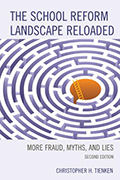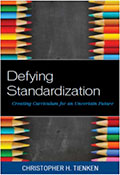The Common Core State Standards in English Language Arts and Mathematics have been advertised by their vendors, the National Governors Association (NGA) Center for Best Practices and the Council of Chief State School Officers (CCSSO), as being superior to previous versions of state standards. The NGA and CCSSO wrote that the Standards are “based on rigorous content and application of knowledge through higher-order thinking skills” and “informed by other top performing countries in order to prepare all students for success in our global economy and society” (NGA Center & CCSSO, 2015, About the Standards). Documentation on the official CCSS website presents “higher-order thinking skills” as a key component of the CCSS (NGA Center & CCSSO, 2015, About the Standards).
Colleagues and I sought to test the vendors’ claims that the English language arts and mathematics CCSS standards were superior in the area of higher-order thinking. Specifically, we compared the percentage of the high school CCSS standards in English language arts and mathematics that required creative and strategic thinking to the former high school versions of the New Jersey Core Curriculum Content Standards in those subjects. The results from the full study will be presented on January 15, 2016 in a peer-reviewed journal published by the American Association of School Administrators. Below are some outtakes and a teaser of the results.
NEW JERSEY CONTEXT
We chose New Jersey because: (a) It is our home state; and (b) New Jersey provides an example of the curriculum and assessment policy changes that took place in almost 40 other states around nation since the 2010 launch of the Common Core. New Jersey adopted the final version of the Common Core State Standards about two weeks after they were released on June 2010. We consider New Jersey an early adopter of the Common Core and the national standards movement.
ANALYSIS FRAMEWORK
We used Webb’s Depth of Knowledge as the Framework for analyzing each set of standards (1997; 2007). Two trained coders reviewed each set of standards and coded them according to one of Webb’s four levels of complexity.
• Level 1 (recall): Standards at this level require examinees to recall a simple definition, term, fact, procedure, or algorithm.
• Level 2 (skill/concept): Standards at this level require examinees to develop some mental connections and make decisions about how to set up or approach a problem or activity to produce a response.
• Level 3 (strategic thinking): Standards at this level require examinees to engage in planning, reasoning, constructing arguments, making conjectures, and/or providing evidence when producing a response. Items at this level require students to do some complex reasoning and make some connections between concepts.
• Level 4 (extended thinking): Standards at this level require examinees to engage in complex planning, reasoning, and conjecturing, and to develop lines of argumentation. Items at this level require examinees to make multiple connections between several different key and complex concepts.
Webb’s Levels 3 and 4 include creative and strategic thinking and provide opportunities for students to experience deeper, analytical, and more divergent types of thinking. Sternberg (1999) asserted that creativity is the “aptitude to generate work that is unique and original as well as suitable for the specific task or problem one is attempting to solve” (p. 3); this comports with Webb’s higher levels of DOK. Webb (1997) views DOK Levels 3 and 4 as the levels at which students have opportunities to be flexible, creative, and strategic in their thinking because they are not bound to converge on one correct answer or to imitate one procedure.
We used a qualitative case study design with content analysis methods to describe and compare the percentages of the CCSS and of the former New Jersey Core Curriculum Content Standards (NJCCCS) in English language arts and math that require students to demonstrate strategic and/or creative thinking. Qualitative content analysis refers to “a research method for the subjective interpretation of the content of text data through the systematic classification process of coding and identifying themes or patterns” (Hsieh & Shannon, 2005, p. 1278). The content analyzed in this study consisted of CCSS and NJCCCS documents presenting the curriculum content standards for grades 9-12 mathematics and English language arts.
Deductive category application was used to connect Webb’s existing Depth of Knowledge framework to the high school CCSS and NJCCSS (Mayring, 2000). Each standard was assigned a 1-4 Depth of Knowledge level based on Webb’s Depth of Knowledge methodology. Utilizing Mayring’s (2000) step model as the guide, a coding agenda was created using the DOK definitions, examples, and coding rules as described in the Webb Alignment Tool (WAT) training manual (Webb, et al., 2005).
FINDINGS
Overall, the high school Common Core State Standards in English language arts and mathematics contained fewer standards rated at DOK Levels 3 and 4 than the 2009 New Jersey high school standards in ELA and math. The results suggest that the standards that NJ bureaucrats had in place prior to adopting the Common Core provided more of the Level 3 and 4 higher-order skills cited in education reform literature as necessary capabilities for competing in a global economy.
For example, Level 1 and 2 Depth of Knowledge complexity accounted for 72% of the high school English language arts Common Core State Standards. Thirty-seven percent (37%) of the 9-12 CCSS English language arts standards were rated at Level 1. Almost 3/4 of the high school English language arts standards do not require creative or strategic thinking as currently written.
We present much more detail about our methods and more in-depth results in the full article. Stay tuned for the January 15, 2016 release.
References
Hsieh, H. F., & Shannon, S. E. (2005). Three approaches to qualitative content analysis. Qualitative Health Research, 15(9), 1277-1288.
Mayring, P. (2000). Qualitative content analysis. Forum: Qualitative Social Research, 1(2). Retrieved from http://www.qualitative-research.net/index.php/fqs/article/view/1089/2385
National Governors Association and Council of Chief State School Officers. (2015). About the standards. Washington, DC: NGA and CCSSO. Retrieved from: http://www.corestandards.org/about-the-standards/
Sternberg, R.J. (1999). The handbook of creativity. New York, NY: Cambridge University Press
Webb, N. L. (1997). Criteria for alignment of expectations and assessments in mathematics and science education (Research Monograph No. 6). Washington, DC: Council of Chief State School Officers.
Webb, N. L. (2007). Issues related to judging the alignment of curriculum standards and
assessments. Applied Measurement in Education, 20, 7–25.
Webb, N.L., Alt, M., Ely, R., & Versperman, B. (2005). Web alignment tool training manual. Wisconsin Center for Education Research. Retrieved from http://wat.wceruw.org/index.aspx


